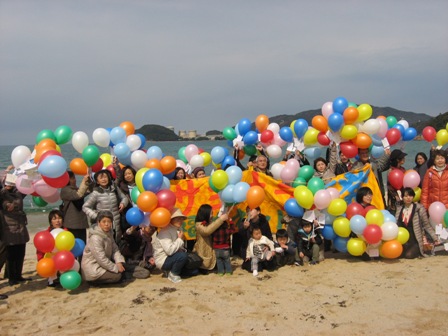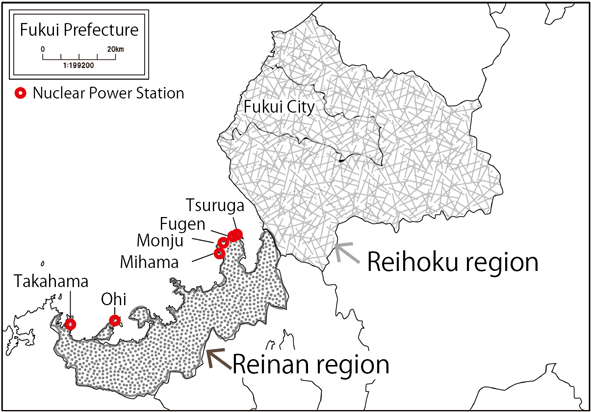Group Introduction From Fukui, the “Nuclear Ginza” Sayonara Genpatsu Fukui Network Nuke Info Tokyo No. 163
Taeko Nakajima
 |
| Releasing balloons from near NPS |
 |
| Location of Nuclear Power Stations in Fukui |
The Sayonara Genpatsu Fukui Network was established in July 2011, four months after the occurrence of the Fukushima nuclear accident that followed the March 11 earthquake.
This network was formed rather spontaneously — it originated from informal gatherings of citizens who had witnessed the tremendous nuclear accident and resolved to stop using nuclear power. In Fukui Prefecture, where we live, there are 15 nuclear reactors (one of which is being decommissioned), and the accident in Fukushima was not someone else’s problem, but ours.
Fukui Prefecture is located near the middle of the Japanese Sea coastline of Japan’s main island. The prefecture has a chain of mountains which divides the prefecture into the northern Reihoku region and southern Reinan region. In the Reihoku region, rice paddies spread out across the plain and this is where Fukui City, the prefectural capital, is located. The Reinan region is a narrow extension of land, which has a long ria coastline (Wakasa Bay). The prefecture has a population of about 800,000, of which 650,000 lives in Reihoku and 150,000 in Reinan. The narrow strip of land on the Reinan coastline is home to the 15 nuclear reactors, and thus the area is called the “Nuclear Ginza” (named after Japan’s busiest shopping district). The area is also home to the fast breeder reactor Monju, which uses liquid metal sodium as coolant and plutonium as fuel, and is more dangerous than commercial light water reactors.
The first reactor in Reinan started up in 1970, and people in the region have cohabitated with nuclear reactors for more than 40 years. An antinuclear movement appeared in the meantime, but many people today are dependent on reactor-related work to earn a living, and it is difficult to speak out against nuclear power. In Reihoku, in contrast, people are unfamiliar with nuclear reactors, reactor operators’ leaflets promoting the safety of nuclear power are distributed to every household regularly, and money from reactor operators is lavishly used to organize various events, which suppresses opinions against nuclear power.
The Fukushima nuclear accident occurred under such circumstances, and we thought we should review the use of nuclear power. Our network was organized on the initiative of Reihoku citizens sharing the same thoughts. Most of our members have not been involved in the antinuclear movement in the past. In September 2011, shortly after the establishment of the network in the July following the Fukushima accident, we organized a lecture about low-dose exposure. Starting from this event, we have organized various events and actions, including lectures, reactor restart protest gatherings and rallies, the submission of statements and open questions to the prefectural government, film screenings, questionnaire surveys to prefectual and city assembly members to sample their ideas about stopping nuclear power, discussions with assembly members, an antinuclear-power panel exhibition, and the releasing of balloons from near nuclear power station sites.
In solidarity with the Tokyo Friday action in front of the Prime Minister office, we are organizing a gathering and rally to express our objection to the possible restart of reactors every Friday evening in front of the Fukui Prefectural Government Office. As of the end of October 2014, we had organized the Friday gatherings 118 times. In October, we organized a panel exhibition and lecture event, entitled “Nuclear Accident and Evacuation — Learning from Fukushima.”
The Sayonara Genpatsu Fukui Network has organized actions beyond the boundaries of Fukui Prefecture. To change Japan’s nuclear policy, we believe that actions coordinated across the nation are essential, in addition to local actions.
==
In May 2014, the Fukui District Court pronounced the Judgment on Claim for Injunction on Operation of No. 3 and No. 4 Units at Ohi Nuclear Power Plant, which stated that the power company must not operate the reactors. The judgment not only cheered us up, but also gave hope and courage to people who believe that all nuclear reactors should no longer be used. The impressive outline of the judgment has been translated into other languages (English, Chinese, Korean, Turkish, and Vietnamese).
“Outline of Judgment on Claim for Injunction on Operation of No. 3 and No. 4 Units at Ohi Nuclear Power Plant” (translated by Greenpeace)
adieunpp.com/download&lnk/ooi-urteil-engl-may212014.pdf



